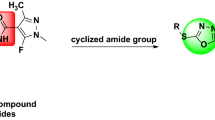Abstract
Six new polyazole derivatives from 2-(2,4-dichlorophenyl)-1,3-dioxolane were studied for their antifungal activity against pathogenic fungi for humans and animals. The antimycotic effect was largely restricted to the filamentous fungi with Aspergillus fumigatus and Scedosporium apiospermum being remarkably susceptible. Three compounds were as effective as the two references, ketoconazole and oxiconazole. The structure-activity relationships revealed that an ‘oxime group’ combined with four chlorine atoms increased the antifungal properties of the chemical series.
Similar content being viewed by others
References
Chabasse D. Les nouveaux champignons opportunistes apparus en médecine. J Mycol Méd 1994; 4: 9-28.
Kwon-Chung KJ, Bennett JE. In C Cann (ed.) Medical Mycology. Philadelphia/London: Lea and Febiger Publishers,1992.
Muller J. The epidemiology of deep-seated, domesticmycoses. Mycoses 1994; 37: 1-7.
Taylor GD, Buchananchell M, Kirkland T, Mckenzie M, Wiens R. Trends and sources of nosocomial fungaemia. Mycoses 1994; 37: 187-90.
Debono M, Gordee RS. Antibiotics that inhibit fungal cell wall development. Ann Rev Microbiol 1994; 48: 471-97.
Delcourt A. Inhibition des groupements thiols et activité antifongique. Effet du N-éthylmaléimide sur la croissance de champignons pathog`enes. J Mycol Méd 1991; 1: 78-81.
Fromtling RA. Overview of medically important antifungal azole derivatives. Clin Microbiol Rev 1988; 1: 187-217.
Borg-von Zepelin M, Eiffert H, Kann M, Rüchel R. Changes in the spectrum of fungal isolates: results from clinical specimens gathered in 1987/88 compared with those in 1991/92 in the University Hospital Göttingen, Germany. Mycoses 1993; 36: 247-53.
Hitchcock CA. Resistance of Candida albicansto azole antifungal agents. Biochem Soc Trans 1993; 21: 1039-47.
Arias A, Arevalo MP, Andreu A, Rodriguez C, Sierra A. In vitrosusceptibility of 545 isolates of Candidaspp. to four antifungal agents. Mycoses 1994; 37: 285-89.
Goff DA, Koletar SL, Buesching WJ, Barnishan J, Fass RJ. Isolation of fluconazole-resistant Candida albicansfrom human immunodeficiency virus-negative patients never treated with azoles. Clin Infect Diseases 1995; 20: 77-83.
Johnson EM, Warnock DW, Luker J, Porter SR, Scully C. Emergence of azole drug resistance in Candidaspecies from HIV-infected patients receiving prolonged fluconazole therapy for oral candidosis. J Antimicrob Chemotherapy 1995; 35: 103-14.
Baji H, Flammang M, Kimny T, Gasquez F, Compagnon PL, Delcourt A. Synthesis and antifungal activity of novel (1-aryl-2-heterocyclyl)ethylideneamino-oxymethyl-substituted dioxolanes. Eur J Med Chem 1995; 30: 617-26.
Baji H, Kimny T, Gasquez F, Flammang M, Compagnon PL, Delcourt A, Mathieu G, Viossat B, Morgant G, Nguyen-Huy D. Synthesis, antifungal activity and structure-activity relationships of 2-(alkyl or aryl)-2-(alkyl or polyazol-1-yl-methyl)-4-(polyazol-1-ylmethyl)-1,3-dioxolanes. Eur J Med Chem 1997; 32: in press.
Polak A. Oxiconazole, a new imidazole derivative. Arzneim-Forsch/Drug Res 1982; 32: 17-24.
Dupont B, Drouhet E. Kétoconazole. Thérapeutique 1982; 12: 1-4.
Dupont B, Dromer F, Improvisi L. The problem of azole resistance in Candida. J Mycol Méd 1996; 6: 12-19.
Author information
Authors and Affiliations
Rights and permissions
About this article
Cite this article
Delcourt, A., Mathieu, G., Baji, H. et al. New polyazole derivatives from 2-(2,4-dichlorophenyl)-1,3-dioxolane. Antifungal activity. Structure-activity relationships. Mycopathologia 137, 27–32 (1997). https://doi.org/10.1023/A:1006837606890
Issue Date:
DOI: https://doi.org/10.1023/A:1006837606890



